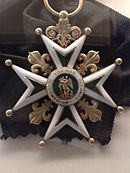Order of Saint-Michel
| Order of Saint Michael Ordre de Saint-Michel |
|
|---|---|

Badge
|
|
| Type | Order of chivalry |
| Country | the Kingdom of France |
| Royal house | Valois, Valois-Orléans, Valois-Orléans-Angoulême, Bourbon, Bourbon-Orléans |
| Religious affiliation | Catholic Church |
| Ribbon | |
| Status | • Obsolete/Defunct/Abolished according to the French Republic • Recognised as dynastic order of chivalry by the International Commission on Orders of Chivalry |
 Collar |
|
The Order of Saint Michael (French: Ordre de Saint-Michel) is a French dynastic orders of chivalry, founded by Louis XI of France on 1 August 1469, in competitive response to the Burgundian Order of the Golden Fleece founded by Philip the Good, duke of Burgundy, Louis' chief competitor for the allegiance of the great houses of France, the Dukes of Orléans, Berry, and Brittany. As a chivalric order, its goal was to confirm the loyalty of its knights to the king. Originally, there were a limited number of knights, at first thirty-one, then increased to thirty-six including the king. An office of Provost was established in 1476. The Order of St Michael was the highest Order in France until it was superseded by the Order of the Holy Spirit.
Although officially abolished by the government authorities of the July Revolution in 1830 following the French Revolution, its activities carried on. It is still recognised by the International Commission on Orders of Chivalry.
As would be expected, the first knights were among the most powerful nobles in France, close relatives of the king and a few from other royal houses in Europe. Originally, the number of members (called companions) was limited to thirty-five. In 1565, during the Wars of Religion, when loyalties were strained and essential, Charles IX increased the membership to fifty but there may have been as many as seven hundred knights under Henry III in 1574.
...
Wikipedia
